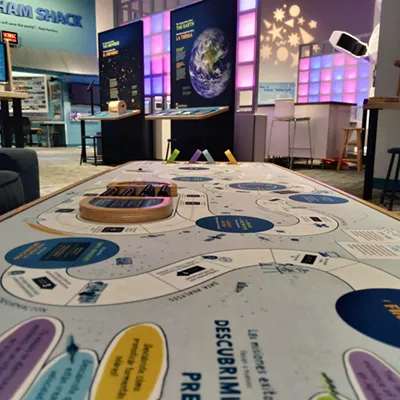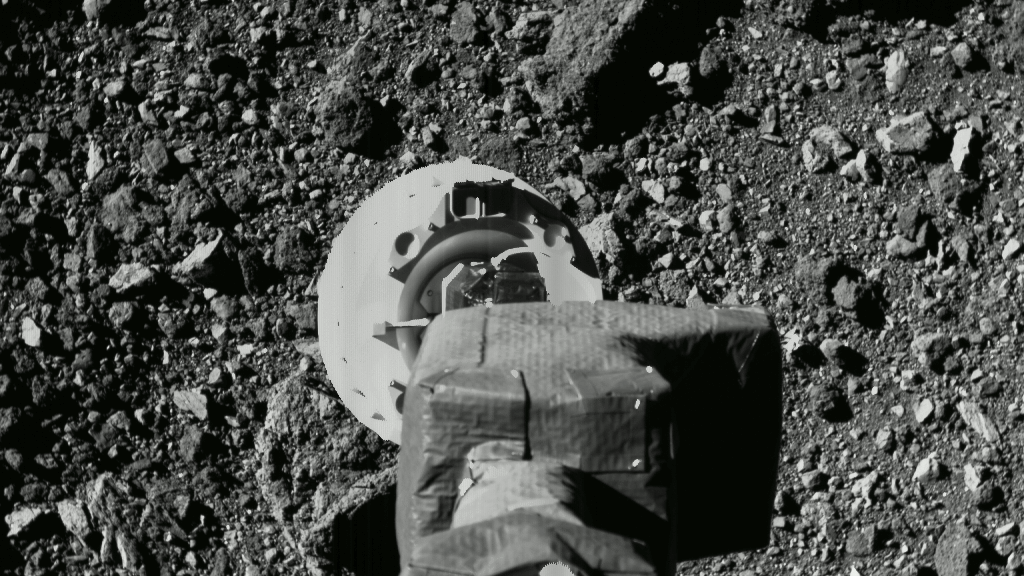"I'm tired of talking about what's gonna happen on this mission," says Smith, who has led the effort to assemble the Phoenix Mars Lander that's set to land this Sunday, May 25. "I just can't wait to get there and start talking about what is happening.
"On the other hand," he adds, "I'm scared, because there's some chance of failure during the landing process."
This may surprise you, but it's not all that easy to land a probe on the surface of Mars. As Ed Weiler, associate administrator for NASA's Science Mission Directorate, noted in a press briefing last week: "This is not a trip to Grandma's house."
The first challenge: You have to be very, very smart.
The UA's Lunar and Planetary Laboratory (LPL) has aptly demonstrated that they've got no shortage of brains. LPL scientists have been at the forefront of the final frontier. They built and are running the HiRISE camera aboard the Mars Reconnaissance Orbiter that has been beaming back stunning images--taken from at least 155 miles above the surface--since 2006. They helped design the orbital camera aboard the Mars Global Surveyor, which took photos of Mars between 1997 and 2006. They were behind the Gamma Ray Spectrometer aboard the Mars Odyssey that launched in 2001. They created the camera aboard the Sojourner rover that sent back images as the buggy rolled around the surface of Mars in 1997.
And that's just Mars. Since being founded in 1960 by astronomer Gerald Kuiper, the Lunar and Planetary Lab has designed and managed cameras aboard the Cassini-Huygens mission to Saturn. Its scientists built and operated the Ultraviolet Spectrometer that was onboard the Voyager mission to Jupiter, Saturn, Uranus and Neptune. They helped figure out what happened after the Deep Impact spacecraft smashed into Comet Tempel in 2005.
In short: These guys know what they're doing.
The next challenge: You have to find a lot of money. Visiting Mars ain't cheap.
Smith got $420 million from NASA as the first project in the space agency's new series of low-cost "scout" missions that are designed to capture a better understanding of Martian climate and geology; pave the way for a manned mission; and--the Big Question--determine whether life exists or ever existed on Mars.
Smith's proposal: land a robot lab near the Martian north pole.
Why the north pole? Because in 2002, William Boynton, another one of those big brains at the Lunar and Planetary Lab, was analyzing fresh data beamed in from the Gamma Ray Spectrometer aboard the Mars Odyssey when he noticed vast sheets of permafrost beneath the surface of the northern plains of Mars. That means there's water--and water could mean life.
"Water is the first step for the search for life on Mars," Smith says. "We're going to a place where we know there's water. We're taking the next step to see if it's a zone where life could exist."
Finding life is pretty much the holy grail (and marketing angle) of space science, but even if scientists don't detect life signs, the mission will provide clues to the conditions that future manned missions to Mars may face. As Smith puts it: "If you were an astronaut going to Mars, wouldn't you want to land somewhere water was available?" (He's quick to add that the north pole might not be the ideal place to set up a base on Mars, in any case.)
Once funding is in place, you have to build a spacecraft. When Smith pitched the mission to NASA, he proposed retrofitting the Mars Surveyor 2001 Lander that had been sitting in storage since its mission was cancelled in 2000. The Surveyor, built by Lockheed Martin, was ready to go, but Smith wanted to modify it.
The team eliminated a few elements--such as a rover that could drive around the landing site--and added a few new accessories.
The new spacecraft--dubbed the Phoenix Mars Lander, after the legendary bird that rises from its own ashes--features a robotic arm that will be able to dig trenches in the permafrost and scoop up samples of soil for delivery to onboard laboratories that will analyze their chemical composition. The robot arm is equipped with a camera so scientists can see what they're digging up.
A second onboard camera will allow scientists to view the area around the landing site, while a meteorological station contributed by the Canadian Space Agency will provide daily weather reports and study the atmosphere.
Once scientists figure out the components that they want to send to Mars, they have to test them. The Phoenix has been chilled in airless chambers and exposed to electromagnetic radiation to ensure it can survive the trip to Mars. It was baked to ensure it could survive the heat of entering the Martian atmosphere. It was rocked by sound waves to ensure it could survive the stress of a rocket launch. It got put through tests to see if it would work if the lab ended up tipped over sideways when it lands.
Scientists ask themselves: If this breaks, then what happens? If that breaks, what happens?
"At every opportunity, there's a recovery path identified," Smith says. "If some things break, there's no recovery--like if your parachute doesn't deploy, you're finished. But for everything that has a backup plan, we've written into the software ways to save the mission."
The team scrubbed down the Phoenix to ensure that it was as free of biological contaminants as possible. Then they trucked it to Cape Canaveral and loaded it onto a rocket.
Last August, a Delta II carried the Phoenix off the planet and up into space, where the probe set off on a 423 million mile trip, checking in for occasional course corrections through NASA's Deep Space Network.
Now comes the hard part: Safely landing on Mars.
Other recent missions on Mars' surface have essentially involved dropping a spacecraft that's packed in a padded ball that breaks open on impact.
However, the Phoenix is using a more difficult landing maneuver, which hasn't been successfully done since the Viking mission in the mid-'70s: a rocket-assisted landing, in which landing thrusters will help the Phoenix touch down after a parachute slows its descent.
Smith knows all about the risks. He was one of the designers of the Mars Polar Lander, which was lost when it attempted to land near the Martian south pole in 1999.
The crash turned Smith's life upside-down. He remembers feeling "utter despair. It seemed like there was no recovery. ... I had another 10 years of missions ahead of me at the time of that crash, and they all fell down like a stack of cards after that. It seemed career-ending for me."
But he's getting a second chance this Sunday, May 25, when the Phoenix finally enters the Martian atmosphere some 78 miles above the surface of the planet.
The spacecraft will be traveling at a speed of close to 13,000 mph. Provided everything goes as planned over the next seven minutes, the Phoenix will be slowed by friction to less than twice the speed of sound before it pops a parachute and sheds the heat shields that were designed to protect it during the entry into the atmosphere.
A set of legs will flip out from the bottom of the Phoenix as it falls. When the craft's radar indicates that it's within a kilometer of the surface, the craft will jettison the chute and fire landing thrusters as it touches down in an area of the northern arctic plains that's been dubbed "Green Valley"--a spot that has been extensively mapped by the Mars Reconnaissance Orbiter.
At 4:36 p.m., Tucson time, the Phoenix should be on Mars. About 17 minutes later, the LPL team hopes to start getting signals at Mission Control--a rehabbed warehouse at Drachman Street and Sixth Avenue.
Once the Phoenix is on the ground, two large solar panels will unfold, and the LPL team will start the latest investigation into the secrets of Mars.
The LPL team will be working with scientists across the globe for the mission, which is scheduled to run 90 Martian days--or about 92 days here on Earth. Each day, the science team will examine the data they've collected and upload new instructions to the computers on the Phoenix.
Once that first 90 days have passed on Mars, the LPL crew can continue to operate the probe, but as the Martian winter approaches, there will be less and less sunlight to provide solar power.
Eventually, the Phoenix will likely end up buried under solid carbon dioxide ice, making the odds slim that it could reactivate next summer.
Smith says he learned from the loss of the Polar Lander to be careful about planning for the future, but he likes to take a long view.
"I think humans are going to Mars one day--probably not in my lifetime, but we're a curious type of people," Smith says. "One day, we'll get enough money together and enough willpower and go off to Mars with a human mission. I see the work I'm doing as preparation for that. Where are the humans going to land, after all? They have to land somewhere interesting. They're not just going to any old place."











